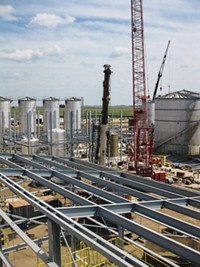Advertisement
Grab your lab coat. Let's get started
Welcome!
Welcome!
Create an account below to get 6 C&EN articles per month, receive newsletters and more - all free.
It seems this is your first time logging in online. Please enter the following information to continue.
As an ACS member you automatically get access to this site. All we need is few more details to create your reading experience.
Not you? Sign in with a different account.
Not you? Sign in with a different account.
ERROR 1
ERROR 1
ERROR 2
ERROR 2
ERROR 2
ERROR 2
ERROR 2
Password and Confirm password must match.
If you have an ACS member number, please enter it here so we can link this account to your membership. (optional)
ERROR 2
ACS values your privacy. By submitting your information, you are gaining access to C&EN and subscribing to our weekly newsletter. We use the information you provide to make your reading experience better, and we will never sell your data to third party members.
Energy
VeraSun To Diversify Into Biodiesel
Major ethanol producer plans to make two biofuels from the same feedstock
by Glenn Hess
November 7, 2006
VeraSun Energy, the nation's second-largest ethanol producer, plans to produce biodiesel from oil extracted from distillers' grains, a coproduct of the ethanol production process.
Brookings, S.D.-based VeraSun, which has filed a provisional patent application for the technology with the U.S. Patent & Trademark Office, says it would be the first company to develop a large-scale commercial facility to make the two biofuels from the same feedstock.
"This opportunity is a natural extension to our business and consistent with our objective to be a leader in the production of renewable fuels," says VeraSun CEO Don Endres. "This technology is particularly strategic to VeraSun because it allows us to extend our large and low-cost producer strategy from ethanol to include biodiesel."
The company says its researchers discovered that the oil in distillers' grains makes "an excellent feedstock" for biodiesel production. Distillers' grains are the substances that remain after starch is removed from corn kernels for fermentation into ethanol. Ethanol refiners usually sell the leftover grains as animal feed for cattle, hogs, and other livestock.
"We have been conducting research and development in the biodiesel area for years, testing and evaluating various technologies," says Matt Janes, VeraSun's vice president of technology. "We're confident this process will allow for large-scale, low-cost, and high-quality biodiesel production."
VeraSun says it is evaluating possible sites for a 30 million-gal-per-year biodiesel facility. It plans to begin construction next year and production in 2008. The company currently operates ethanol plants in Aurora, S.D., and Fort Dodge, Iowa. A third facility is under construction in Charles City, Iowa, and additional facilities are planned for Welcome, Minn., and Hartley, Iowa. When the new plants are completed, VeraSun says it will have capacity for approximately 560 million gal of ethanol per year.
The Bush Administration and many members of Congress have been touting expansion of the biofuels industry as a way to help reduce U.S. dependence on foreign sources of oil. Energy legislation enacted in 2005 requires refiners to blend 4 billion gal of renewable fuels into the U.S. gasoline supply in 2006 and gradually increase the volume to 7.5 billion gal in 2012.
The number of ethanol plants in the U.S. has nearly doubled since 2000 to 101, and 44 more are under construction, according to the Renewable Fuels Association. Investment in biodiesel has been even more dramatic. Over the same six-year period, the number of biodiesel plants has jumped from 10 to 86, and 78 more are under construction, according to the National Biodiesel Board.
Output of biodiesel is expected to reach 150 million gal this year, double the 75 million gal produced in 2005. Forecasters in the Department of Energy predict that demand for biodiesel will increase to more than 1 billion gal by 2010 and then double to 2 billion gal by 2020. Biodiesel can be blended with petroleum diesel to run in all existing diesel engines.



Join the conversation
Contact the reporter
Submit a Letter to the Editor for publication
Engage with us on Twitter